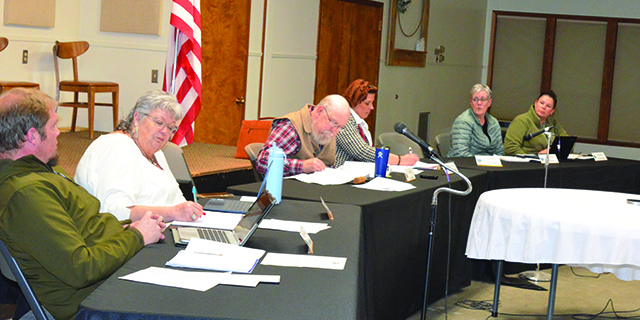HOLD: Illness levels on the riise in Wallowa county
Published 7:00 am Wednesday, January 18, 2023

- Wallowa Memorial Hopsital.
If you live in the area, chances are you or someone you know is sick or was this season. You may have a lingering cough, persistent sniffle and feel tired and achy. Some folks are saying they are on their second round of antibiotics and still have not kicked the symptoms of what may be related to what medical experts are calling the “Tripledemic”.
According to Oregon Health News
The three big viruses spreading this season are COVID-19, respiratory syncytial virus (RSV) and influenza (the flu). All three are respiratory viruses, and they primarily affect your sinuses and throat. These viruses spread from droplets created when an infected person coughs, sneezes or talks. Viruses can also spread when you touch a surface that has infected droplets on it, such as a doorknob or someone’s hand, then touch your own eyes, nose or mouth.
Recent Oregon Health & Science University (OHSU) modeling, published Jan. 6, shows that flu levels probably peaked in mid-December but remain high in Oregon. The modeling also shows that the number of COVID-19-positive patients in hospitals increased after months of holding steady. RSV cases peaked in November but also remain elevated. While cases are trending downward, we are still not out of the woods. Case numbers remain well above average and continue to strain our hospital system.
Since it was first identified in late October (in New York), Omicron subvariant XBB.1.5 has rapidly outcompeted other Omicron subvariants and is believed to now represent more than 70% of cases in the northeast United States. XBB.1.5 comprised an estimated 27.6% of COVID-19 cases in the United States during the first week of 2023. At the same time, the Omicron subvariant BQ.1.1 represented an estimated 34.4% of cases, but health experts expect XBB.1.5 to overtake BQ.1.1 soon and become the predominant variant in the U.S. and around the world.
XBB.1.5 can be thought of as a “great grandchild of Omicron.” It probably started when a person was infected with Omicron subvariants BA.1.10.1 and BA.275 simultaneously. When the two subvariants replicated in that person’s body, they swapped genes to create a new subvariant—XBB. And XBB.1.5 is an offspring of XBB. It’s the latest example of the COVID-19 virus (SARS-CoV-2) mutating to become more contagious.
XBB.1.5 possesses a number of mutations including one that is very good at binding to human respiratory cells and replicating. This adaptation has helped make it likely the most contagious variant of COVID-19 to date.
“This new subvariant is a perfect example of how the SARS-CoV-2 virus is capable of adapting to selective pressure through mutations and re-combinations with earlier variants,” said Xuan Qin, Ph.D., director of clinical microbiology at Oregon Health & Science University (OHSU) and a professor of pathology in the OHSU School of Medicine.
Is XBB.1.5 more severe?
Although it is highly contagious, there is no evidence to suggest XBB.1.5 causes more severe illness than previous COVID-19 strains. Additionally, the immunity from vaccinations and previous infections helps reduce the chance of severe disease. The new bivalent booster will provide protection against XBB.1.5 and staying up to date on your COVID-19 vaccinations is still the best way to protect yourself from severe disease.
Because XBB.1.5 is more contagious, leading to more cases, COVID-19-related hospitalizations are expected to rise. The latest statewide forecast from OHSU anticipates the arrival of XBB.1.5 will offset previously expected declines in COVID-19-related hospitalizations.
As COVID-19 continues to spread, it will also continue to mutate and create new variants or subvariants. Omicron has dominated for more than a year now.
“This variant will not be the last we see,” said Bill Messer, M.D., Ph.D., associate professor of molecular microbiology and immunology, and medicine (infectious diseases) in the OHSU School of Medicine. “We are going to have to figure out how we ‘greet’’ the new variants, much like we look to see what influenza will do each year: Are the changes big, or small? Will the vaccine work? What else should I be doing to protect myself, my family and my friends and colleagues from getting seriously ill? Masking, hand hygiene, covering your mouth when you cough, staying home when you’re ill and getting vaccinated all will be important.”
In Wallowa County
The latest variant data released on Jan. 18 showed there were two cases of COVID and a weekly average of one case.
“We do not currently have anyone hospitalized due to COVID and haven’t for some time,” said Brooke Pace, Director of Communications at Wallowa Memorial Hospital.
“As healthcare professionals, we are constantly planning for the next outbreak. It is why we have policies, procedures, and protocols (including isolation protocols), and surge plans in place that we regularly reviews. For an example, due to a significant increase in influenza and RSV currently, our Incident Command Team is stood back up and our surge plan is in place.”
“Medical workers have learned a lot about versatility and flexibility. Although the entire healthcare system is still trying to recover from shortages in workers, supplies, and medication, we have learned to maximize our resources, skills and abilities.” Say Ruthie Mann, RN, and Director of Infection Control and Employee Health at Wallowa Memorial Hospital.
Regionally hospitals continue to communicate and resources as needed in Eastern Oregon. We know that the pandemic also had a large effect on the mental wellbeing of our employees and the population as a whole. We continue to support our staff through our employee assistance programs and through educational events around burnout, depressions, and anxiety.





